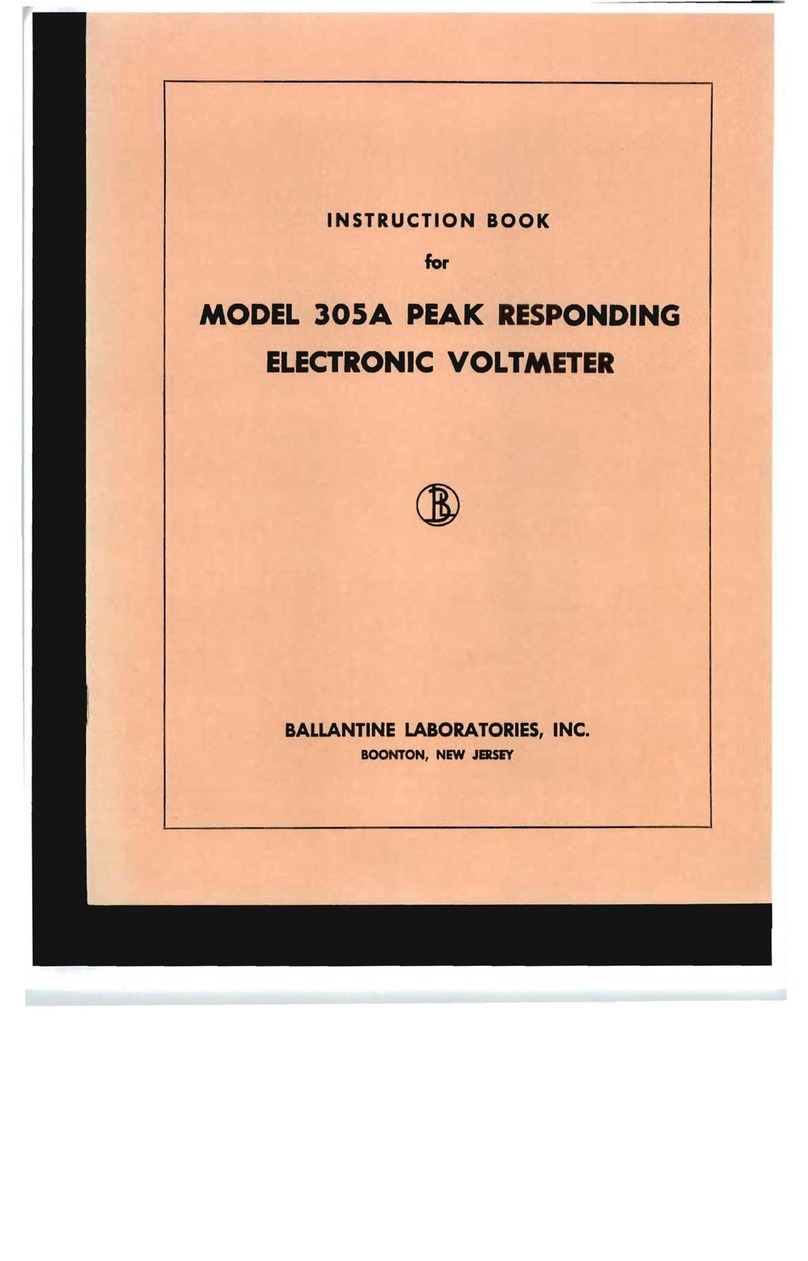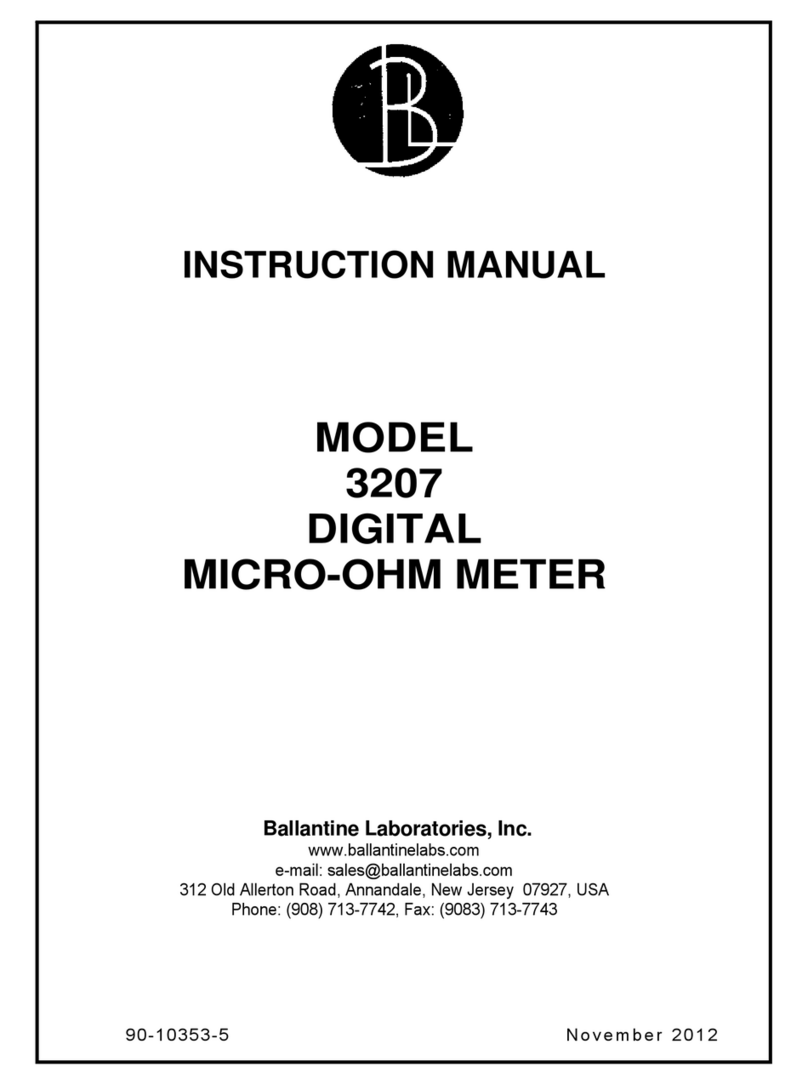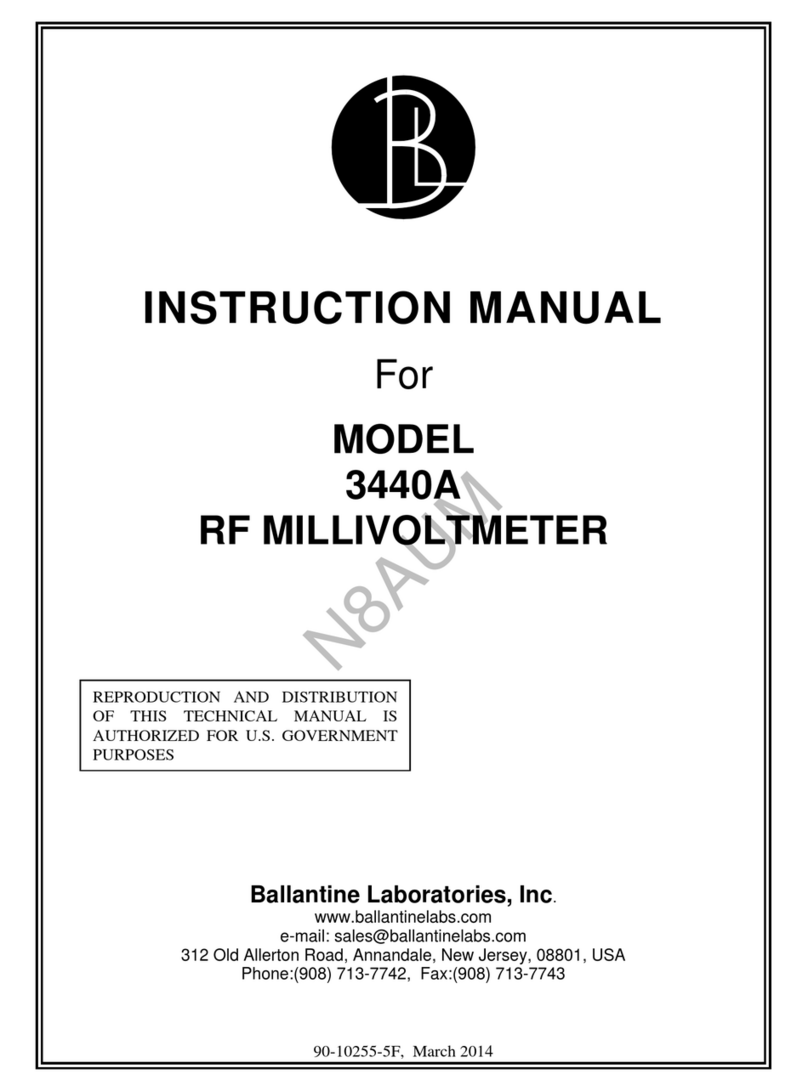
2.5.7
Stray Field Pickup
is
particularly troublesome
at high frequencies. Any loop in the signal input cir-
cuit can have a voltage induced in it that
is
proportional
to the area of the loop, the stray field density, and
the frequency.
Again, coaxial connections are the best when stray field
pickup
is
suspected. Location and removal of the of-
fending sources should be tried, and every attempt
made to reduce the loop area at the signal input.
2.5.8
Transmission Line
Effects
have to be consid-
ered whenever the distance between the voltage to be
measured and the Model 340 probe input
is
not negli-
gibly short compared to a wavelength. The Model 340
is
a high impedance device and will therefore introduce
reflections on any transmission line. These reflections
produce a voltage standing wave pattern. The magni-
tude of the voltage standing wave radio determines the
maximum difference that can exist between the source
of voltage to be measured and that indicated by the
Model 340. The actual difference will depend
on
the
distance between the source and the Model 340.
Figure 5 shows the error that will exist when the
Model 340
is
connected to the voltage source by a
short section of 50 ohm coaxial transmission line. This
set of curves
is
derived from transmission line equations
and the input capacitance of the Model 340 (see figure
4).
%ERROR
§::§.
XIOO
Es
30
LENGTH
(L)
IOcm
5 3 3
_I
I I
I~'""""
i/
:I
, I
OF
PROBE
OR
PROBE
-[-"LENGTH
(L)
ATTENUATOR
I I!/
INPUT I
~c/
I '
E
MODEL
340
ij
I
Ill\
PROBE!
I '
If
I
I
1----
ER
BELOW
30mV
·'l
,),
!j
·--ER
ABOVE
30mV 1
I
20
1
I
I
I
I
I
em
If
I I
10
f
~J
/V
,)
//
,
~
~
v v
,~~~
...
~
...
::,
b.:=
-~
...
.,.:::.;
0
20
30
50
70
100
200
300
500
700
FREQUENCY
IN
Me
ER
_ I
L•=1.2XI0-sf(cpslL(cm)
~
-COSL0-
aS1Nl
0 a
::;;;;
wC~o
Fig. 5. Model
340
Transmission
Line
Errors
Transmission line effects can be minimized
by
shorten-
ing the length of connection between source and Model
340. This may require the construction of specially
threaded adapters that will connect to the ground of
the Model 340 probe.
Transmission line effects may also be minimized
by
measuring
in
a matched 50 ohm transmission system.
For this application the Model 340 probe is first con-
nected to the Model 5340 Tee Adapter which
is
then
connected to the
50
ohm transmission line where the
measurement
is
desired. The maximum vswr of this
. 5 •
system
as
a function of frequency is shown in figure
6.
This tabulation shows the maximum errors that can
exist due to reflections caused by the Model 340, assum-
ing the transmission line itself
is
perfectly matched.
1.30
1.20
0::
3=
en
>
1.10
1.00
/
L
/ v
f.--
~
v
,/
--
-v
100
200
300
FREQUENCY
IN
Me
Fig. 6. Model
5340
VSWR
INPUT
>30mV
I
I
I
v
I INPUT
<37
/ v
500
700
2.5.9
Ground Current
Errors
can be particularly
troublesome whenever low-level, high frequency volt-
ages are measured. Special circuit precautions have
been made
in
the Model 340 to reduce the effects of
ground currents -either currents of power line fre-
qunecy or high frequencies. However, particularly with
high frequency ground currents, it
is
impossible to
completely eliminate these effects. Therefore every ef-
fort should be made to reduce the leakage from signal
sources into the power line ground. Avoid positioning
power line cords close to the Model 340 or to any low-
level sources that are being measured.
Work
at the
highest possible measurement levels.
2.5.10. Response and Waveform Errors are mini-
mized
in
the Model 340 because the instrument re-
sponds to the rms value of the input signal. This feature
is
particularly important
in
the calibration of the Model
340. All high frequency calibration devices (Micro-
potentiometers, A-T Voltmeters,
HF
Transfer Volt-
meters) are rms-responding.
When
they are used to
calibrate a Model 340, errors due to distortion in the
signal sources will be minimized.
The rms feature of the Model 340
is
likewise important
when measuring unknown voltages. Distortion
in
the
voltage will not lead to the uncertain reading of a peak-
responding or average-responding instrument. How-
ever, particularly at high frequencies, response and
waveform errors must still be considered when using
the Model 340.
If
the signal being measured
is
con-
nected to the Model 340 over a finite length
of
trans-
mission line -which in practice
is
always the
case-
and if the signal contains higher frequency harmonics,
these harmonics will be transmitted over a longer elec-
trical length than the fundamental. This longer length
will alter the amplitude of the harmonics at the input
of
the Model 340, in relationship to the amplitude of






























